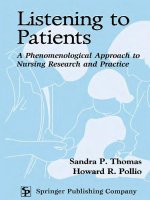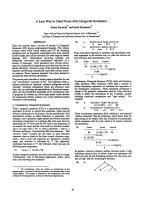A Special Addition to Staying Healthy: An English Learner’s Guide to Health Care and Healthy Living ppt
Bạn đang xem bản rút gọn của tài liệu. Xem và tải ngay bản đầy đủ của tài liệu tại đây (11.99 MB, 37 trang )
Women’s Health
A Special Addition to Staying Healthy: An English
Learner’s Guide to Health Care and Healthy Living
Florida Literacy Coalition
Florida’s Adult and Family Literacy Resource Center
2010
This publication was made possible through a grant from the
Florida Department of Education, Division of Career and Adult Education.
Funding was provided through the Workforce Investment Act, Title II,
Adult and Family Literacy, Section 223.
Women’s Health
A Special Addition to Staying Healthy:
An English Learner’s Guide to
Health Care and Healthy Living
Naomi Soto,
Maria Koonce,
Gregory Smith
Focus Group at Orlando Tech
Sonia Magarinos, Myriam Qualit, and their
students
Invaluable Others
Blue Cross and Blue Shield of Florida
The Susan G. Komen Race for the Cure
Quizaira Recio, Bryan McCormack, Erin Balleine,
Yari Payne, Raychel George, Sharon Smith, and
Jordana Frost
ACKNOWLEDGEMENTS
We would like to acknowledge and thank the following individuals and organizations for their support
in the development of this publication.
Florida Department of Education,
Division of Career and Adult Education
Development Team
Naomi Soto, Maria Koonce, Gregory Smith
Health Literacy Program Coordinator
Naomi Soto
Graphic Design
Corey Alexander
Expert Reviewers
Julie McKinney, Lillian Nieves, Nelly Ford,
Pam Fulton, Melissa Berlin, Amada Soto, LPN, and
Heide Castañeda, PhD, MPH
CREDITS
Stock Photography and Illustrations by
ISTOCKPHOTO®, BIGSTOCK®, DREAMSTIME®, and the Susan G. Komen Race for the Cure
Copies of Staying Healthy: An English Learner’s Guide to Health Care and Healthy Living, and its
additional components Women’s Health and Coping with Stress may be ordered by contacting the
Florida Literacy Coalition, Inc. at (407) 246-7110. This publication and all additional components can
be downloaded for free at http://www.oridaliteracy.org.
The opinions expressed herein do not necessarily represent the positions or policies of the Florida
Department of Education. This resource is designed for educational purposes only. The information is not
intended to substitute for informed medical advice. You should not use this information to diagnose or
treat a health problem or disease without consulting a doctor or qualied health care provider. This book
provides links to websites to help you nd health information and services. Florida Literacy Coalition does
not necessarily endorse or recommend the organizations that produce these websites or the information
they provide.
What Does the Female Reproductive System Do?
The female reproductive system is in the pelvis. The pelvis is located between the hips. It includes
the organs that only women have. The female reproductive system allows a woman to:
store eggs •
have sex •
protect a baby while it grows •
give birth•
Functions of Female Reproductive Organs
Ovaries:• Women have two ovaries. Each ovary sends an egg to the uterus every other month.
Cervix: • It joins the uterus to the vagina.
Uterus:• An organ that holds the baby until birth; also called the womb. It connects the cervix
and the fallopian tubes.
Fallopian tubes: • Tubes that connect the ovaries to the uterus. The eggs go through the
fallopian tubes into the uterus.
Vagina:• It connects the cervix to the outside of the female body.
01
Women’s Health - Part I: Healthy at All Ages
Common Stages of
Birthing and Parenting
Menstruation
monthly bleeding,
having your period
Pregnancy
carrying a baby inside
the womb (uterus)
Childbirth
when the baby
comes out of the
womb and is born
Taking Care of
Your Baby
making sure your baby
is healthy and
growing strong
Menopause
when periods begin
to stop and eventually
stop completely
PART I - HEALTHY AT ALL AGES
Women can do something very special
that men cannot do: give birth to
children. Having a baby is a very special
time for many women.
It is important to know if your body is
ready to have baby. This means you
should be physically and emotionally
healthy.
What is menstruation?•
What is menopause?•
How do I plan for pregnancy and childbirth?•
How do I care for my baby?•
This chapter will answer these questions:
02
This book is not meant to diagnose any medical condition or
problem. It is a tool to help you understand your body and your
doctor’s visits. Talk to your doctor about any specic concerns
or worries.
Major Changes in a Woman’s Life
There are two normal changes in a woman’s life: menstruation and menopause. These changes are
the start and the end of fertility. Fertility means being able to have children. Women should not
feel ashamed about these changes.
Menstruation
Menstruation (the period) is a normal event in a
woman’s life cycle. It usually begins between the ages
of 8 and 13. It is the start of the reproductive age
called puberty. When a woman has her period, she
bleeds through the vagina. It happens every month
and usually lasts three to ve days. Many women
have cramps during this time.
COMMON PERIOD MYTHS
“You can’t get pregnant during your period.”
“Virgins shouldn’t wear tampons.”
“Women with their period shouldn’t go swimming.”
03
Women’s Health - Part I: Healthy at All Ages
Periods Aect Your Body and Your Feelings
Menstruation aects how many women feel. This is called PMS (Premenstrual Syndrome).
Some symptoms may continue after the period starts.
PHYSICAL SYMPTOMS
cramps
pain
headaches
bloating or
feeling fat
changes in
sexual desire
breast swelling
nausea
getting annoyed
very quickly
tiredness
mood swings
depression
EMOTIONAL SYMPTOMS
There are dierent things that women can
do if they have PMS and period
symptoms. Simple lifestyle changes can
help. These include:
heating pad or hot water bottle •
medicine•
regular exercise•
a healthy diet•
little or no alcohol or caeine•
04
Menopause
When a woman can no longer have a baby, she goes through
menopause. This usually occurs when a woman is between
45 and 55 years old. Menopause is when a woman stops
menstruating (having her period). It is a natural event and not a
disease, but it is a big change that aects all women.
Menopausal women may experience many changes in their
bodies. The following symptoms are common during menopause:
Hot ashes• make you feel hot all over the body.
Mood swings• are when you change from feeling
happy to feeling sad very quickly.
Vaginal dryness• occurs because the body has less
estrogen. Estrogen is a hormone that is higher in
women. When women have less estrogen, sex may
feel uncomfortable or painful.
Feeling tired or having trouble sleeping.•
Periods become irregular• and then stop.
Osteoporosis• is when bones become weak.
Weight gain• is more likely.
What Can I Do to Treat My Menopause Symptoms?
It may take time before your know what treatment is best for you.
However, hormone replacement therapy (HRT) can
treat menopause.
HRT treats and may change your hormone levels. Hormones are
chemicals naturally released in your body. Dierent hormones
make you feel a dierent way. When a doctor changes your
hormone levels, the way you feel may change, too. Always ask
your doctor what might happen.
BE PATIENT!
05
Women’s Health - Part I: Healthy at All Ages
Treat Menopause
with Lifestyle
Changes
Keep a good diet.
Stay active.
Lifestyle Changes
There are easy lifestyle changes that you can make that may
help you treat the symptoms of menopause. Relief may take
longer, but there are fewer risks than hormone replacement
therapy.
Women who maintain a healthy lifestyle before menopause
often nd it easier to cope with its symptoms. Eating a
balanced diet and staying active are two major ways to stay
healthy during menopause.
Keywords
cramps: pain near the pelvis during periods
fertility: being able to have a baby
estrogen: hormone strong in women
hormones: chemicals in the body
hormone replacement therapy: doctor puts extra hormones
in your body to help you cope with menopause
menopause: when periods stop and you can no longer
become pregrant
menstruation: monthly bleeding from the vagina
mood swings: changes in emotions
myth: something that is not true
osteoporosis: disease that weakens one’s bones
periods: same as menstruation
puberty: usually starts between the ages of 8 and 13, as
children grow into adult bodies
Avoid smoking.
Limit alcohol.
Find ways to relax.
Dress in light layers.
06
Key Points
Menstruation and menopause are natural and normal.•
Ask your doctor how to treat the symptoms of menstruation and •
menopause.
Check Your Learning
1. What is menstruation?
o A sign of being pregnant
o Bleeding through the vagina
o The end of puberty
2. Which can be symptoms of menstruation or PMS?
o Cramps, headaches, depression, and short temper
o Breast swelling, upset stomach, and bleeding from the vagina
o All of the above
3. What is menopause?
o Getting your period for the rst time
o A disease that aects women
o When a woman stops having her period
4. How can you treat menopause symptoms?
o Smoke
o Eat healthy and be active
o Eat only fried foods
07
Women’s Health - Part I: Healthy at All Ages
What to Expect During Your
Pregnancy & Delivery
Women have many options to avoid pregnancy.
Once a woman is pregnant, her body will go through
many changes. Pregnant women also have many
options to deliver and to take care of their babies.
Pregnancy
If a woman has not reached menopause yet, she may
decide she wants a baby. If she does not practice birth
control, she may become pregnant. This means that
she is carrying at least one fetus. A fetus is a baby when
it is still in the womb.
08
Conception is the start of the pregnancy.
This occurs when sperm from a man reaches
a female egg during sex. The rst sign of
pregnancy is usually a missed period.
What Can I Expect
During Prenatal Care?
Questions about
medical history
Physical
examinations
Blood and urine
tests
Ultrasound: pictures and
video of the fetus
Before and during pregnancy, it is important to have special
health care, or prenatal care. Your doctor will probably refer
you to an obstetrician or gynecologist, for regular visits.
This doctor is often referred to as an OB/GYN.
PRE = BEFORE
NATAL = BIRTH
PRENATAL = BEFORE BIRTH OR DURING PREGNANCY
During your prenatal visits, your doctor will likely talk to you about:
eating a balanced nutritious diet •
NO• smoking, drinking alcohol or taking drugs
taking vitamins•
You will also hear your doctor use the word trimester. Every pregnancy has three trimesters: the
beginning, middle, and end of the pregnancy. Each trimester lasts for three months, and certain
growth and symptoms occur in each one. For instance, morning sickness or feeling sick to your
stomach is more common in the rst trimester.
09
Women’s Health - Part I: Healthy at All Ages
A Pregnancy
May End Early
When it happens
accidentally it is
a miscarriage.
If it happens by a
medical procedure it is
an abortion.
MAKE SURE YOU KEEP
YOUR DOCTOR’S AND THE HOSPITAL’S
PHONE NUMBERS AVAILABLE FOR YOU
AND YOUR FAMILY.
HAVE AN OVERNIGHT BAG READY.
What Will Happen to My Body While Pregnant?
The most obvious physical change in pregnancy is weight gain.
As the baby grows, your belly will get bigger to make room for it.
Other symptoms may be:
Back pain•
Constipation•
Sore breasts•
Feeling tired•
Wanting unusual foods•
Heartburn or nausea, especially in the morning•
Hemorrhoids•
Increased urination•
Swelling, especially of feet•
10
When Does the Baby Arrive?
Childbirth usually occurs about 40 weeks
after conception. This is considered being
“at full term.” A baby will most often be
stronger and healthier the closer it is to full
term. More time in the womb gives the baby
time to fully develop.
The pregnancy may feel very uncomfortable
towards the end. Having your baby as close
to full term usually increases your chances of
having a healthy baby!
Unusual Pregnancy Symptoms Include:
a high fever strong nausea, chills
hard pains feeling dizzy
bleeding contractions
baby moves less or
does not move at all
having an accident
or serious fall
You should call your doctor when you have unusual symptoms. Do not wait too long to contact
your doctor, because the symptoms may be warning signs.
Three Major Signs That the Baby is Coming!
When the baby is fully developed, it will be ready to come out. • Contractions begin when the
uterus starts getting ready to push and deliver the baby. They will feel like very strong cramps.
The cervix will widen to make room for the baby. This is called • dilation. You won’t notice this,
but the doctor can check it.
The last major sign of childbirth is when the • water breaks. There will be uid leaking from the
vagina when the bag surrounding the baby breaks.
11
Women’s Health - Part I: Healthy at All Ages
The Baby is on its Way!
A normal delivery is a vaginal birth. This
means pushing the baby out when
having contractions.
However, if there are complications,
the doctor may do a C- section or a
Cesarean surgery. This means that the
doctor takes the baby out in an
operation.
Things You Can Do to Help Deliver the Baby
Ask your doctor about pain medication.
Sleep or walk between contractions.
Concentrate on breathing.
The baby’s father, family member or friend can help you during labor.
Keywords
abortion: a medical procedure to end pregnancy
conception: getting pregnant
contractions: tightening of the uterus
C-section: baby taken out of mother through surgery
dilation: cervix widens so baby can come out
fetus: baby inside mother’s body
miscarriage: losing the fetus naturally
obstetrician/gynocologist: a doctor for women and pregnancy care. Often referred to
as an OB/GYN.
pregnancy: a woman carries a baby inside her body for nine months until it is born
prenatal care: taking care of yourself and seeing your doctor regularly when you are pregnant
trimester: the beginning, middle and end of a pregnancy. Each part lasts three months.
12
Key Points
Pregnancy begins at conception, nine months before the baby arrives.•
Having a healthy pregnancy helps your baby.•
Visiting the obstetrician regularly and taking good care of yourself •
helps you have a healthy pregnancy.
Check Your Learning
1. What is conception?
o Miscarriage
o The start of a pregnancy
o When a baby is ready to be born
2. What is a symptom of pregnancy?
o Getting thinner
o Having more energy
o Morning sickness or an upset stomach
3. What is a vaginal birth?
o A C-section
o An abortion
o A normal delivery
Caller: Hello, I am four months pregnant, and I am running
a high fever.
Clinic: How high?
Caller: 101 degrees.
Clinic: Do you have any other symptoms?
Caller: I am also dizzy and have chills.
Clinic: Please go to the hospital right away. Check into the
Emergency Room.
Dialog
13
Women’s Health - Part I: Healthy at All Ages
BREASTFEEDING
Free
Fights infections naturally
Convenient
Helps you lose weight
Mothers are totally responsible for feedings
Can prevent many diseases
Expensive
Mix correctly, keep in refrigerator
Wash bottles & bottle nipples thoroughly
Throw away unused formula
Father and others can feed baby
Warm carefully & test before feeding baby
FORMULA
VS
Breast Pumps Can Help!
Babies can drink breast milk even while mothers are at work or away
from the child. Breast pumps allow mothers to store breast milk for
babies to drink later.
Health departments often have breast pumps you can borrow to
encourage mothers to breastfeed their new babies. You can also buy
them at many department stores and drug stores.
If you are a new mother and are having trouble breastfeeding,
your doctor or nurse can help you.
Store-bought baby formula is another way to feed a new
baby. Formula must be prepared to provide nutrition for the
baby.
Choosing What’s Right
For Your Baby
When a baby is born, there are many things the new
mother must do to feed and keep her baby safe.
Breastfeeding vs. Formula
One of the rst decisions a mother will have to make is
whether to breastfeed or to formula-feed her baby.
Breastfeeding is when the child drinks milk straight from
the mother’s breast. This may be dicult for some new
mothers, but there are many benets to breastfeeding.
14
Vaccinations
It is very important that you take your baby and young
children to the doctor for regular checkups. These visits
with your child’s doctor will help make sure your baby
is healthy. Children’s doctors are called pediatricians.
Pediatricians also give your baby vaccination shots.
Vaccinations are injections that prevent serious diseases.
These visits are often called well baby visits
because you go when your child is not sick.
You go to keep your child WELL.
Keywords
breastfeeding: giving the baby your breast milk
breast pumps: allow women to pump breast milk to feed their baby later
formula: special powder that you can buy to feed your baby
pediatrician: children’s doctor
vaccination: injections against disease
well baby visits: doctor appointments for children to prevent sickness
Check Your Learning
1. What ghts infections for babies?
o Breastfeeding
o Water
o Formula
2. What should you do during regular checkups for your baby?
o Ask if your baby is developing ok
o Avoid follow-up questions
o Avoid asking any questions about vaccinations
15
Women’s Health - Part I: Healthy at All Ages
Pediatrician: I am so glad to see that Kyra is
doing so well!
Mom: Thank you, Doctor. I just wondered if
she should have a u vaccine.
Pediatrician: Let me look at her record. She’s
18 months old and has had all vaccinations.
Since this is October, I suggest that we give
her the u vaccine.
Mom: What will this do for her?
Pediatrician: The u virus strikes in the
winter. It can be serious. The vaccine helps
Kyra avoid getting the u. Kyra has been very
lucky and healthy. I think it’s a good idea to
give her the vaccine.
Dialog
Florida WIC
WIC is a free program for Women, Infants and Children.
WIC provides healthy foods, nutrition education, breastfeeding support
and referrals to health care.
For more information and to see if you eligible call
1-800-342-3556 or visit www.doh.state..us/family/WIC.
ENJOY YOUR BABY IN GOOD HEALTH!
16
How Can I Learn More?
Information
Kids Health
The National Women’s Health Information Center
/> />Family Doctor
National Healthy Mothers, Healthy Baby Coalition
/>What to Expect When You’re Expecting: Baby Basics Series
/>Healthy Roads Media
/>La Leche League International (website available in several languages)
Activities
Centers for Disease Control, pregnancy worksheets
/>La Leche League Podcasts
/>Free or Low Cost Services
Breastfeeding Hotline
/>Florida WIC
http://www.oridawic.org
17
Women’s Health - Part II: Stay Healthy, Stay Safe
PART II - STAY HEALTHY, STAY SAFE
Learning About
Female Health &
Safety
Cancers
Treatment
Domestic Abuse
Sexually Transmitted
Infections (STI’s)
How do I know if I have a cancer that women get?•
How can I prevent an STI?•
What should I do if someone is being abused? •
This chapter will answer these questions:
Be Safe! Know Your Body!
Women should check their bodies regularly. They need to look
for any changes in their bodies. Women also should make
regular visits to the doctor. This unit will discuss health and
safety issues.
Cancer• is a disease that can attack the body in
dierent ways. Small pieces of the body, called cells, grow
too much, and create a tumor.
STIs • (Sexually Transmitted Infections) are diseases that
spread through sex.
Domestic abuse• is when someone that lives with you
hurts you. This can be very dangerous. If it happens, you
should tell someone right away.
18
How Do I Know If I May Have Breast Cancer?
Breast cancer aects many women. Women should look for
breast cancer signs. See your doctor right away if you notice any
of these changes:
Lump or hard knot in or around the breast•
Swelling, warmth, redness of the breast•
Change in the size and shape of the breast•
Changes in the skin of the breast•
It appears as if the nipple pulls into the breast•
Fluid comes out of the nipple•
New pain in one spot that does not go away•
WOMEN CAN GET:
breast cancer
(in the breast)
ovarian cancer
(in the ovaries)
cervical cancer
(in the cervix)
uterine cancer
(in the uterus)
It is very important to know what is normal for you and your body. A breast self-exam (BSE) is
a tool that may help you learn what is normal for you. BSE includes looking at and feeling your
breasts. If you notice any changes in your breasts, see your health care provider right away. He or
she may send you to get a mammogram.
What is a Mammogram?
A mammogram is an X-ray or
picture of the inside of a breast.
Women over 40 years old should get
a mammogram every year. Ask your
doctor which screening tests are
right for you if you are higher risk.
Some Cancers Aect Mainly Women
19
Women’s Health - Part II: Stay Healthy, Stay Safe
Studies have shown that BSE used alone does not decrease mortality rates.
Susan G. Komen for the Cure does not provide medical advice.
Reprinted from Breast Self-Awareness Card, May 2010
with the permission of Susan G. Komen for the Cure®.
Breast Self-Awareness (BSA)
and Steps to a Breast Self-Exam (BSE)
20
Risk Factors
A risk factor is something that may increase your
chances of getting a disease. Some risk factors for breast
cancer include:
family history of breast or ovarian cancer •
getting older•
being overweight•
beginning menstrual periods before the age of 12 •
going through menopause after 55 years old•
drinking alcohol•
hormone replacement therapy to treat menopause •
having the rst child after age 35 years old•
•ovaries•cervix•uterus
These parts of the body are only in women.
Some signs of these cancers are:
pain near the stomach •
hurts to urinate•
not as hungry as usual •
feeling sick/upset stomach•
diarrhea •
pain near or around the pelvis •
bleeding from the vagina•
There may be dierent reasons for these signs. It is better to go to the doctor to nd the reason.
Get regular checkups and pap tests (Papanicolaou test). A pap test can save your life. It can nd
early signs of cervical cancer. If caught early, there is a very good chance of curing cervical cancer.
What Other Kinds of Cancer Can I Get?
Reproductive cancers may occur in the following organs:
A tumor is a growth in the body that is not normal.
Benign tumors do not contain cancer, and they do not spread.
(Benign means “not dangerous.”)
Malignant tumors are cancer. They can kill you.
It is very important to treat malignant tumors as soon as possible.
(Malignant means “bad.”)
21
Women’s Health - Part II: Stay Healthy, Stay Safe
HPV Vaccine
HPV (the Human Papillomavirus) is a very common virus that can
cause cervical cancer. Half of sexually active people have HPV.
There is an HPV vaccine that can prevent some forms of cervical
cancer. A vaccine is a shot or series of shots given by the doctor.
Ask your doctor if the HPV vaccine is right for you.
What Are My Treatment Options?
The earlier you nd cancer, the better your chances of successful treatment! Your doctor will help
you decide what is the best option for you. There are several options for treating cancer.
Chemotherapy -• chemicals and medicine are put in the body to destroy cancerous tumors.
Radiation therapy -• Radiation and heat is applied to the body to destroy cancerous tumors.
Hormonal therapy -• A combination of hormones is added to the body to destroy tumors and
cancer. Hormones are released naturally in the body. More hormones can be put into the body
by a doctor.
Surgery -• A surgeon removes the tumor or cancer.
Keywords
benign tumors: tumors that do not contain cancer
breast: part of body that gives milk to babies
breast self-exam: a tool that may be used to know what is normal for you
cervix: connects the uterus and vagina
chemotherapy: chemicals and medicine are put in the body to destroy cancerous tumors.
eggs: tiny particles released by the ovary that turns into a baby with a man’s sperm
fallopian tubes: tubes that connect the ovaries to the uterus
hormonal therapy: a cancer treatment that uses hormones
malignant tumors: tumors that are dangerous and threaten life
mammogram: a picture of the inside of a breast
nipple: tip of the breast that provides milk for baby
ovaries: female organs that make eggs
pap test: a test that looks for changes in the cervix
pelvis: area between the hips with female organs
radiation therapy: radiation and heat is applied to the body to destroy cancerous tumors.
surgery: doctors can remove tumors during surgery
tumor: an unusual growth somewhere in the body
uterus: a female organ that holds the baby until birth; also called the womb
22









